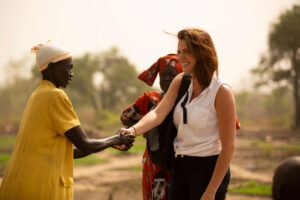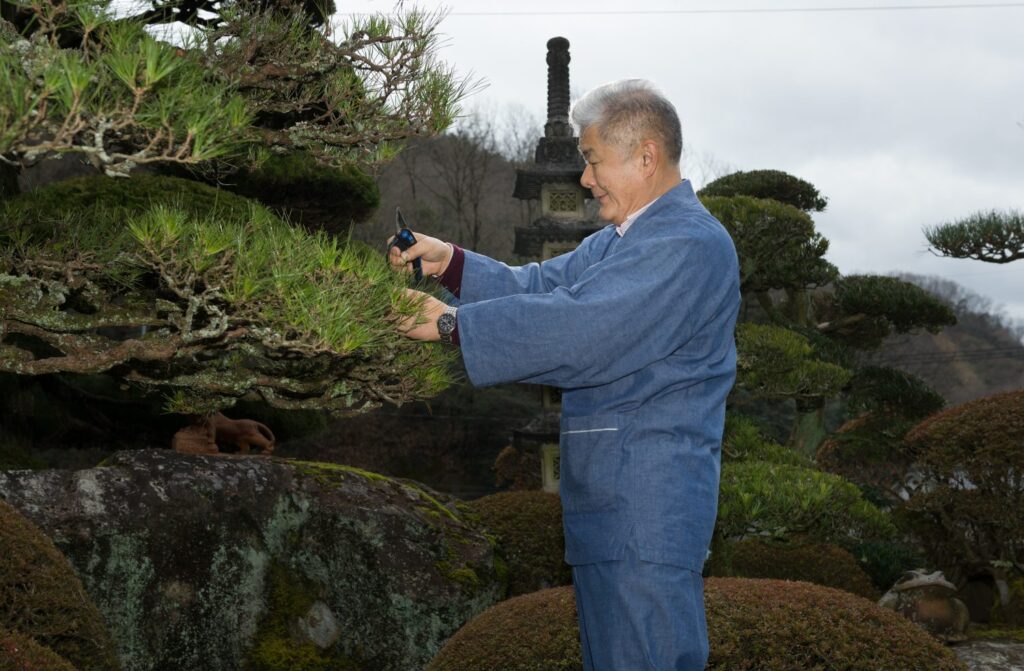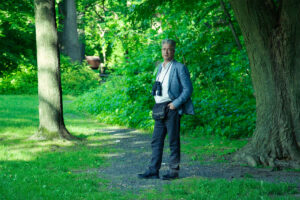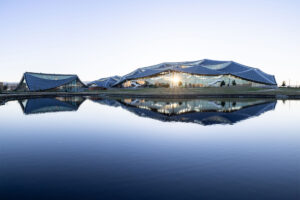
Obakki – A Purpose-Led Lifestyle Brand and Foundation
Founder Treana Peake, supports artisan partnerships and funds development work through the Obakki Foundation.
Japan
Celia Albers September 12, 2019
Tatsushi Kuroki has made a career of infusing sustainability into the denim production process.
Tatsushi Kuroki is the President and CEO of Kuroki Mills, and an internationally renowned sustainable denim manufacturer in Japan. He is committed to the implementation of more environmentally responsible initiatives into the production process, such as recycling and purifying the dye water and using more solar power. These are just some of the many ways he seeks to improve upon the company foundation his father laid.
But Kuroki didn’t always plan to go into the family business. He was a student of electrical engineering. The opportunity to join his father arose when jeans were “at the peak of trend” – and he took it. His fascination with the universal, timeless appeal of jeans has carried him throughout his career, all the way to his current position at the helm of Kuroki Mills. The company is headquartered in Okayama, Japan, which has grown into a hub for denim production. To Kuroki, both sustainability and success hinge on creating something meaningful that lasts. Whether it is durable denim or a thriving career in question, Kuroki has accomplished it. But he isn’t resting anytime soon. We had the pleasure of an in-depth conversation with Kuroki with the kind arrangement of Jetro—
Tatsushi Kuroki: I was born and raised in Saichigo, which is an area located in Nishiebara town, Ibara city, Okayama Prefecture. The history of this region dates back for more than 800 years, when Nasu no Yoichi, a Samurai from the Kamakura period retrieved the land from the Genji clan at the War of Yakushima in 1185.
Mood of Living: Where did you grow up and go to school? Did you study textiles?
TK: I grew up in Saichigo, Nishiebara town and attended Nishiebara Elementary School, Ibara Middle School, and Ibara High School. For university I attended Osaka Electro-Communication University and majored in electronic engineering and industrial engineering. It was not until 1975 when I joined Kuroki Ltd. that I learned about fiber and textiles. Initially I was assigned to the apparel division, not the division for denim production.
TK: Kuroki Ltd. was founded by my father Tamotsu Kuroki in 1950. At this time, we manufactured and distributed cotton cloth for clothing and industrial materials. In the 1960’s we begun producing Hank dyed denim using Kovanol coloring, transitioning to indigo rope dyed denim by 1965. By 1970, denim production and distribution of jeans material became the focus. In 1974 the sales division of Kuroki Woven Cloths was separated and Kuroki Ltd. was founded. In 1976, Kuroki Woven Cloths became a company and became Kuroki Woven Cloths Ltd.
TK: In the Edo Period that dates more than 400 years ago, the areas in west and south Okayama and east Hiroshima were called Bicchuu, Bingo, and Bizen. Han, the public administration at the time, encouraged growing cotton and indigo as to establish local industry and stimulate the economy. Yarn was made from the harvested cotton which would get dyed in indigo and then woven into textiles. These woven materials were used to make kimono wear for the general public. In the Meiji and Taisho era, the industry accelerated its development especially with the Industrial Revolution from the west. After WW2, importing used vintage jeans from the USA became increasingly popular, and you’d see them being sold at Tokyo’s Ame-Yoko and from there, all over the country. This created the movement to produce denim domestically in Japan. Many sewing houses became prevalent in Ibara and Kojima, Kurashiki. Initially they imported Made in USA denim such as from Conemills. However, as the popularity grew, that of Made in Japan denim grew, seeing regionally produced denim yielding this region to become the hub for denim production. At peak times, 80% of domestic denim was produced in Ibara.
MoL: What inspired you to become involved in the denim industry versus other textiles?
TK: 1975, when I joined the company, jeans were at the peak of trend. Every youngster wore jeans. However, at that time, many industries including textile, automobile production and electronics assembly were in the midst of a high-growth period, which gave me career options. At that time in Japan, the textile industry appeared to lose its momentum. Since my expertise was in electronic engineering, my professor, also the CEO of a measurement equipment manufacturer, strongly encouraged me to join his company. I entertained the idea for a moment. However, my family was in the textile business. If Kuroki was still producing cotton cloth for kimono clothing, I might have taken the offer. However, the fact that the company was producing denim made me reconsider. Denim has been, and will be worn world-wide, and the thought excited me. I decided to dedicate my career to denim production.
TK: As mentioned earlier, cotton and indigo is harvested in the local region of Ibara city since the Edo period, approx. 400 years ago. At that time such things as chemical fertilizer and pesticides did not exist, so by default the way indigo dyed garments were produced were the ultimate way of sustainable garment production. Importing cheaper cotton harvested with pesticides and chemical fertilizers became the norm, and natural indigo was replaced by chemical indigo made with oil. However, I have always been concerned with the impact on the environment. For example, Ibara is a city with abundance of nature with quality source of water. The purified water gets used for agriculture and then flows into the river ending up in the Setonaikai sea. When we opened the Kuroki dyeing facilities in 1996, I was most mindful of the water quality. We use a machine that purifies four times that of the standard machine, which is drinking water grade, and then we drain the water out. This is one of the examples of Kuroki embodying the spirit of sustainability and eco-friendliness. Currently our dyeing facility is operating as part of the Ibara spring water cycle.
MoL: Are there other practices you hope to introduce to your business to continue to be at the forefront of environmental sustainability? What is your commitment to sustainability for the future?
TK: More than ten percent of the electricity Kuroki uses is generated by solar power. We plan on increasing the usage of solar power. 80 percent of the lights in the office are LED, and we plan on using more BCI, organic cotton and natural indigo. We also plan on increasing the production of 100 percent organic cotton denim and 100 percent natural indigo denim, since synthetic indigo is reported to contain Aniline, a chemical that is toxic to the environment. Denim created with quality materials, precision, and care costs more. It will last longer while cheap, low-quality products can not stand the test of time and results in multiple re-purchases. Kuroki believes creating quality products that can last longer is the spirit of true sustainability.
MoL: What designers do you work with? Why do you think they’re drawn to your craft?
TK: I cannot disclose the designers who use Kuroki denim, but we have relationships with most major European brands. Our quality is superb, top-notch, with a lot of options with weights, weaves, and colors. If they order through Kuroki they can receive the needed sample in no time.
MoL: Have you always been a start-to-finish production facility? How does this process work?
TK: The production procedure of the denim is cotton-yarn-dye-weaving-finishing. Initially, at Kuroki we used to purchase the yarn, dye at an outsourced dyeing facility, weave internally and outsource the finishing. To control the quality, and lead time and manage production issues effectively, we built Kuroki Merchant Facility to finish the material in 1988 and Kuroki Dyeing Facility, which is a rope-dyeing factory in 1996. We still source the yarn externally to have greater selections but finish the whole production process thereafter in-house.
MoL: Why is indigo so important and intrinsically tied to the history and production of denim? Where do you source your indigo?
TK: Before chemical dyes, pigments were derived from plants and minerals. Indigo has been harvested and used as one of the most popular dyes worldwide. After denim was born in Europe and indigo became the common ingredient to dye denim, it was introduced to the USA. Denim became the staple for physical laborers, gold diggers, and pioneers who cultivated the nation. The tough and easy-to-wear material was ideal for the harsh conditions such workers were placed in. Indigo has the added benefit of repelling poisonous snakes and insects which protected these laborers. Today, denim has become a universal garment worn and loved by everybody.

MoL: How do you maintain a work-life balance? Do you find time to cook and eat well?
TK: Basically, I prioritize my work. For my private life, I’m a member of the Rotary Club and I enjoy serving Rotary activity. I take golf and swim lessons. I started playing golf when I was 18 so I have been playing it for 48 years. I’m not so good at it, but I enjoy it. I recently went to visit somewhere close to Seattle and played golf for three days. I swam in a river when I was little and started taking lessons five years ago. This helps me stay healthy. My wife is a good cook so I don’t touch it. I love food cooked with vinegar. I love any kind of sushi, of course, especially Matsurizushi (A kind of sushi that is made of vinegared rice either mixed with finely chopped cooked egg or fresh vegetables, excluding vinegared raw foods). Okayama prefecture, where I live, is facing the Seto Inland Sea. We can have various kinds of seafood such as crabs, mantis shrimp, snapper, mackerel, and many kinds of small fish. These are tasty and I love them all. Also, Okayama is famous for beef. We have many kinds of good food in the area. *About Matsurizushi: In the Edo Period the lord of Chikuzen Okayama, Mitsumasa Ikeda issued the Thrift Ordinance which ordered to have only “one soup and one side dish” for a meal. Matsurizushi was then invented to get past the order by putting a lot of fish and vegetables with sushi rice but still looking as “one side dish.”
MoL: What advice would you give to someone looking to get into the textile industry?
TK: If I talk about just denim textiles, the population of the earth will continue to increase over the next decades so that demand for denim will be increasing as well. More denim factories would be constructed. In this situation, there would be two ways to pursue the denim textile business. One is to develop new denim for the new era and focus on cost performance and mass production. The other one is to focus on creating good quality denim and provide good service like we do. You need to find customers who appreciate the quality and understand why the price is high. It’s your choice which way you would like to go, but I will continue to pursue the second direction.
MoL: If you weren’t working in the denim industry now, what would you be doing?
TK: Considering what I studied in school, I guess I would be working with electricity, semiconductors, software, or producing electric devices.
MoL: How does nature impact your design process and how you live? Do environmental changes impact your work?
TK: The area I live in, Ibara city, Okayama prefecture has lots of nature. I think I can relax and think well because of the environment. I’m very sensitive to pollution because of where I live. Especially water pollution. The rivers in the area flow into the Seto Inland Sea, so the government’s environmental standards are extremely strict. Both public institutions and factories control and drain water that is at a much lower level than the Japanese standard.
Tatsushi Koroki Family
MoL: What other dyes are you currently interested in aside from indigo? Are these other dyes similarly sourced from local plants?
TK: Besides chemical indigo, Kuroki Ltd. has been using natural indigo plants for over 20 years. It has been popular in Europe, USA, and Japan. Our natural indigo color is a special color that chemical indigo is not able to recreate. There is an area called AONO in Ibara city, Okayama prefecture which produces grapes. I tried to use the grapes to dye denim but it didn’t work out. Unfortunately, its color was not dark enough to dye.
MoL: What adds meaning to your life?
TK: I believe it is very important to accomplish something in my life and to make it possible, I must keep making efforts. My favorite motto is “continuity is the father of success”. There is an old Chinese book called Caigentan. It teaches you how you should set your mind when you are in good/bad conditions and what is necessary to keep going.
MoL: Do you have any words of wisdom?
TK: Life is like an intertwined rope. When you make a hemp rope, one would go up and the other one would go down. There are good times and bad times. Tomorrow is another day. Nothing is eternity. You might feel like you have bad luck forever when you are in trouble, but that is not true.
Photography courtesy by Kuroki

Founder Treana Peake, supports artisan partnerships and funds development work through the Obakki Foundation.

Steven Peck is dedicated to creating greener, healthier & resilient cities with nature & urban agriculture.

Leading sustainable architect working on scalable innovations to deliver on Google’s 2030 Carbon aspirations and the hybrid future workplace.